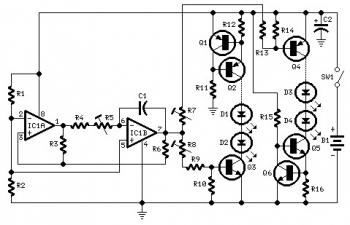Components part:
| R1, R2 = 4K7 R3 = 22K R4 = 1M * R5 = 2M2 * R6, R10, R11, R14, R15 = 10K R7, R8 = 47K Trimpot * R9, R13 = 27K R12, R16 = 56R | C1 = 1µF C2 = 100µF/25V D1-D4 etc = 5 or 3mm LEDs * IC1 = LM358 Q1, Q2 ,Q4 = BC327 Q3, Q5, Q6 = BC337 SW1 = SPST miniature Slider Switch B1 = 9V PP3 Battery |
Circuit Works:

The IC1 contains two Op-Amps circuit which will be used to generate triangular wave form.. The rising and falling voltage obtained at pin #7 of IC1 drives two complementary circuits formed by a 10mA continual current source (Q1, Q2 and Q5, Q6) and driver transistor (Q3 and Q6).
R4, R5 & C1 are the timing components: the total period can be varied changing their values. R7 & R8 vary the LEDs brightness.
Fading LEDs Circuit Notes:
- For those whishing to avoid the use of trimmers, suggested values for 9V supply are: R4=3M9, R9 & R13=47K and trimmers replaced by a short.
- Whishing to use a wall-plug adapter instead of a 9V battery, you can supply the circuit at 12V, allowing the use of up to 6 LEDs per strip, or at 15V, allowing the use of up to 7 LEDs per strip.
- In this case, the value of the trimmers R7 & R8 should be changed to 100K.
Fading LEDs Circuit Source: RedCircuits
